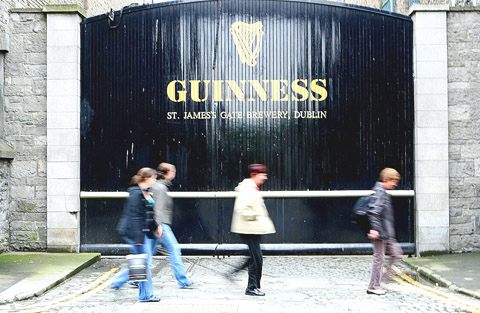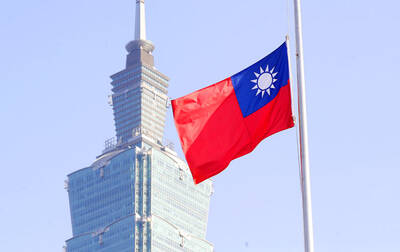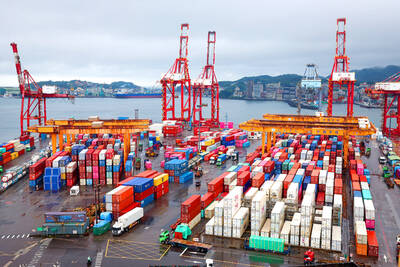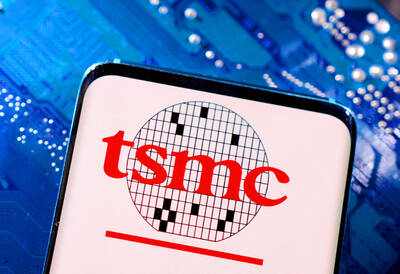For two-and-a-half centuries St James’ Gate in Dublin has been the home of Guinness.
Diageo, the famed Irish stout’s British-based parent company and the world’s largest producer of alcoholic drinks, brews a billion pints a year of the “black stuff.”
Recent weeks were abuzz with press speculation that Diageo would sell the world brand’s historic birthplace and build a new brewery outside the city. Irish Guinness drinkers had taken it hard.

PHOTO: AP
“If Guinness pulled out of St James’s Gate, I’d never drink Guinness again — and I have been drinking Guinness for 38 years, with an average of 40 pints a week,” said Martin O’Mahony, a 59-year-old engineer in Cork city on Ireland’s south coast.
But the speculation has — in part at least — been proven wrong. Diageo said on Friday it plans to invest 650 million euros (US$1 billion) in the St James’s Gate brewery — and also a new production plant at a location yet to be announced outside Dublin.
“Our ambition is to create a brewing hub which will meet the highest standards of technology, efficiency and environmental management,” said Diageo chief executive Paul Walsh.
Guinness brews its distinctive stout not only in Ireland but also at global locations that include Nigeria, which has the company’s third best-selling market after the UK and Ireland.
Beside Guinness, Diageo offers many international known brands like Smirnoff vodka, Johnnie Walker whisky, Captain Morgan rum and Baileys liqueur.
Guinness’ plans include an investment of 70 million euros in parts of the existing facilities at St James’s Gate, a Diageo spokesman said.
After upgrading, about 50 percent of the existing brewing facilities at St James’s Gate would be sold, the spokesman said.
The new plant would produce Guinness to meet growing export demand, plus other ales and lagers, from 2013 onwards. St James’ would produce Guinness primarily for the Irish and British markets.
Simultaneously, Diageo plans to close down two breweries in smaller towns in Ireland’s north, and southwest of Dublin, involving a net reduction of 250 employees in Ireland.
Guinness workers can look back on a long history. The first to brew beer at St James’ Gate was Giles Mee in 1670. The site takes its name from one of the old gates into Dublin.
In 1759, Arthur Guinness began brewing there. West Indies Porter — a precursor to modern-day Guinness — was first brewed in 1801.
In 1886, Guinness was the first major brewery listed on the London Stock Exchange, being the largest brewery in the world with annual production of 1.2 million barrels.
Today, St James’ Gate site is Ireland’s biggest tourist attraction with more than 940,000 visitors per year,at 12 euros a head.
The original storehouse, a seven-floor building constructed in 1904, serves as a visitor center with bars, shops and a training center.
Originally, beer was stored here in huge vessels of oak and pine, later of aluminum. In the 1960s, the storehouse had an overall capacity of 39,300 barrels.
Under Diageo’s current plans, the historic storehouse will continue to develop to accommodate growing visitor numbers, now expected to surpass 1 million people a year, the company said.
Naturally, the storehouse is not the only thing foreigners are attracted to.
“I like Guinness,” said Melow Bivona, a 26-year old who works for Apple Inc in Ireland.
“If you taste Guinness, it tastes like a bit of Ireland,” he said.
It’s a view shared by locals.
“Guinness is Ireland,” said 40-pints-a-week O’Mahony.

ELECTRONICS BOOST: A predicted surge in exports would likely be driven by ICT products, exports of which have soared 84.7 percent from a year earlier, DBS said DBS Bank Ltd (星展銀行) yesterday raised its GDP growth forecast for Taiwan this year to 4 percent from 3 percent, citing robust demand for artificial intelligence (AI)-related exports and accelerated shipment activity, which are expected to offset potential headwinds from US tariffs. “Our GDP growth forecast for 2025 is revised up to 4 percent from 3 percent to reflect front-loaded exports and strong AI demand,” Singapore-based DBS senior economist Ma Tieying (馬鐵英) said in an online briefing. Taiwan’s second-quarter performance beat expectations, with GDP growth likely surpassing 5 percent, driven by a 34.1 percent year-on-year increase in exports, Ma said, citing government

‘REMARKABLE SHOWING’: The economy likely grew 5 percent in the first half of the year, although it would likely taper off significantly, TIER economist Gordon Sun said The Taiwan Institute of Economic Research (TIER) yesterday raised Taiwan’s GDP growth forecast for this year to 3.02 percent, citing robust export-driven expansion in the first half that is likely to give way to a notable slowdown later in the year as the front-loading of global shipments fades. The revised projection marks an upward adjustment of 0.11 percentage points from April’s estimate, driven by a surge in exports and corporate inventory buildup ahead of possible US tariff hikes, TIER economist Gordon Sun (孫明德) told a news conference in Taipei. Taiwan’s economy likely grew more than 5 percent in the first six months

SMART MANUFACTURING: The company aims to have its production close to the market end, but attracting investment is still a challenge, the firm’s president said Delta Electronics Inc (台達電) yesterday said its long-term global production plan would stay unchanged amid geopolitical and tariff policy uncertainties, citing its diversified global deployment. With operations in Taiwan, Thailand, China, India, Europe and the US, Delta follows a “produce at the market end” strategy and bases its production on customer demand, with major site plans unchanged, Delta president Simon Chang (張訓海) said on the sidelines of a company event yesterday. Thailand would remain Delta’s second headquarters, as stated in its first-quarter earnings conference, with its plant there adopting a full smart manufacturing system, Chang said. Thailand is the firm’s second-largest overseas

Taiwan Semiconductor Manufacturing Co’s (TSMC, 台積電) market value closed above US$1 trillion for the first time in Taipei last week, with a raised sales forecast driven by robust artificial intelligence (AI) demand. TSMC saw its Taiwanese shares climb to a record high on Friday, a near 50 percent rise from an April low. That has made it the first Asian stock worth more than US$1 trillion, since PetroChina Co (中國石油天然氣) briefly reached the milestone in 2007. As investors turned calm after their aggressive buying on Friday, amid optimism over the chipmaker’s business outlook, TSMC lost 0.43 percent to close at NT$1,150